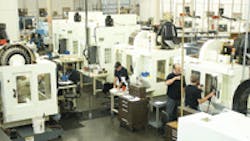Some have called it the future of manufacturing, others the Holy Grail. MTConnect might be a lot of things, but one thing it's not is a new idea.
For years, industry has hungered for a standardized communications protocol -- a uniform way of collecting, transmitting and leveraging data from machine tools. That is entirely at odds with the way machine tools have traditionally been operated over the last 15 years. Each might have its own unique controls, using a specific software, output and language.
But all that appears to be changing as manufacturers begin adopting MTConnect, the open communication protocol standard for interconnectability between machines, independent systems, devices and higher-level applications.
"It has the potential to be a game-changer," says Mark Conley, manager of the CAM/EDI center at Remmele Engineering Inc., a Minneapolis-based manufacturer of medical devices and aerospace and defense components.
Remmele Engineering was among the first companies to participate in a pilot project for applying the standard, working with the Association of Manufacturing Technology (AMT), which was a driving force behind the development of MTConnect.
Eighteen months ago, Remmele began collecting alarms and messages generated by its CNC machine tools, then correlated that information back to the machining processes being executed at the time. While the machining software suggested the machines were performing well, MTConnect was able to transmit data proving gaps existed, allowing the software and machine to correct itself.
"We were just trying to figure out what MTConnect would mean to us as a manufacturer," says Conley. "You had this data coming off the machine in a very advanced way and we were trying to understand how we could improve the performance and health of the machine. It was remarkable."
MTConnect is far from the first attempt at establishing a uniform standard for machine tools. As manufacturers sought to bring automation into their facilities, experts in and outside the industrial realm realized that integration would become a necessity. But previous efforts have been undermined by an endless holding pattern, as suppliers waited for customers to demand the standard, while customers held back for suppliers to offer a broad range of compliant products and applications.
That tug-of-war was largely avoided in respect to MTConnect. Two years ago, at the International Machine Tool Show (IMTS), two dozen equipment manufacturers implemented the standard onto their machine displays, as all were interfaced to a single network application that instantly displayed its status. The demonstration was a hit, proving to both vendors and users the concept could be easily applied across industry.
According to Paul Warndorf, vice president of technology at AMT and liaison to the MTConnect development committee, the effort now is being made to get software vendors to incorporate MTConnect, which would allow an ERP system to process how the machine tools throughout a facility are running -- providing a clearer window into real-time productivity.
As manufacturers begin adopting MTConnect on a larger scale, they will see several waves of benefits. The first and most obvious one, says Remmele's Conley, is the immediate accessibility of factual data that is neutral and not tied to one software developer.
"You'll be able to understand through sensors the machine's health," says Conley. "You will have thresholds you can set in the system and it will alert the user the machine is no longer capable of producing a part because the spindle needs to be replaced."
While some might believe MTConnect represents completion of a quest, to Paul Warndorf, it's really just a bridge for information -- not an answer.
"It's all about different devices, but common connections," says Warndorf. "It sort of goes back to that old BASF commercial, where they say, 'We don't make the surf boards. We make them better.' Well, MTConnect is really an enabler. It's a bridge."
See Also:
